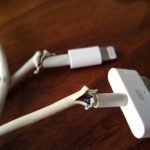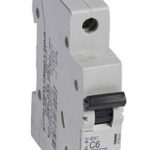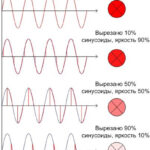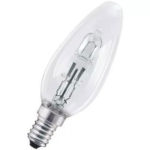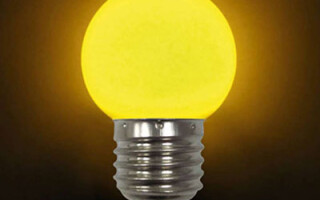LED lights are rapidly gaining market lighting equipment for the obvious advantage. Traditional light sources have no competitive advantage. But some owners of LED lights are faced with an unpleasant situation - after opening the contacts of the switch, the device continues to glow not at full intensity or flashing. This phenomenon can and should be dealt with, but first of all it is necessary to find out the cause.
Content
Why LED lights can dim after you turn them off
At the heart of this unpleasant situation is the ability of LEDs to glow even at a small current (although not at full intensity). But the reasons for this current when the switch is open can be different.
Switch with LED indicator
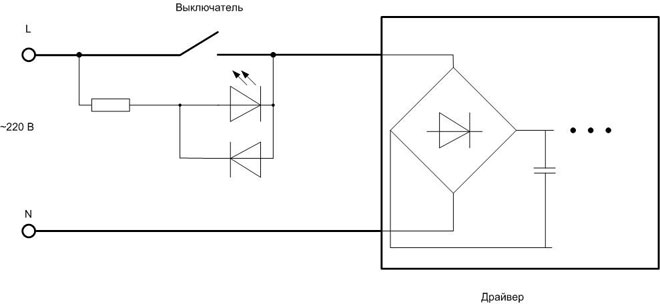
At home, switches with LED (or halogen) lights are popular in households. When used in conjunction with incandescent lamps, these switching elements do not pose a problem. The small current required to ignite the backlight is limited by a resistor, and it is clearly not enough to glow a traditional lamp. LED lights are another matter. The small current can charge the input capacitor of the electronic driver. Accumulating a charge and discharging periodically through the circuit, the capacitor can cause the LEDs to flash. If the lamp uses a circuit with a ballast resistor, the current may be enough to make the LEDs glow dimly.
Faulty electrical wiring
The glow when the switch is open can be caused by leakage currents in the mains. With aging insulation, leakage currents can appear anywhere and cause voltages to appear at the most unexpected points. This generates small currents, but they can cause a weak glow of the LED luminaires.
Influence of capacitive coupling
In some cases, leakage occurs through capacitive coupling. One capacitor is formed by the phase or neutral wire. The other is a nearby wire, an earthed metal element (fixture), a raw wall or floor slab, etc. With a megohmmeter this problem is difficult to detect - it works with constant voltage.
Capacitive coupling between the phase wire and the neutral wire can create a problem if there is a small voltage on the neutral lead. This is common and is caused by asymmetrical loads on the phase conductors. Then when you break the phase wire with a switch, there will be a small current through the capacitance between the wiring of one fixture, which will be enough to ignite the LED.
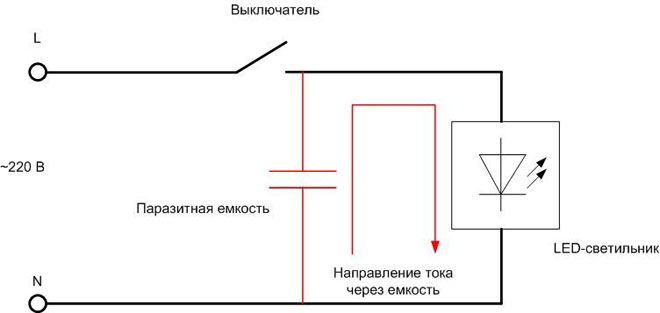
It is also possible to have a surge problem. If another conductor, loaded with a heavy load, is laid in parallel to a phase or neutral conductor nearby and for a long period of time, the current flowing through it creates a noticeable electromagnetic field. It can induce sufficient current in the lines nearby.
Poor quality LED light bulb
If inexpensive light bulbs from unknown manufacturers in Southeast Asia are used for lighting, poor workmanship can also be the cause of unauthorized glow:
- Poor quality insulation causes leaks inside the light bulb itself;
- Cheaper technical solutions are used to stabilize the LED operating current, which can cause problems.
It is impossible to predict the imagination of the manufacturer in this direction. With a single purchase, such a device is easy to identify during the initial inspection. If a defect is detected, the purchase can be abandoned. But this problem can be missed when buying a large batch of fixtures (for example, for an organization) - it is impossible to check all the devices. And the defect may not manifest itself immediately.
Incorrect connection of LED luminaire
Switching circuit of the lamp can be assembled incorrectly - when you turn off may not open phase conductor, but the zero conductor. With a small leakage or capacitive coupling in the circuit will create conditions for current to flow through the light-emitting elements. This situation is also dangerous in that even if the switch is open, the light-emitting elements will be energized by the mains. This creates a real risk of electrocution when repairing or maintaining the lighting system.
How bad is it that an LED light bulb stays on after it is turned off
The unauthorized glow of a light fixture creates a number of problems:
- Flashing or a dim glow can be annoying. Especially if the LED lamp is used for lighting bedrooms, hotel rooms, etc.
- This mode significantly reduces the life of an expensive device. Constant glow, albeit in a weakened form, reduces the service life by a factor of two or more.
- Dull light caused by leaks indicates problems with the wiring insulation. And it's something to pay attention to and take action to prevent the fault from developing.
Therefore, when a problem occurs, you should find out the cause of the glow as quickly as possible and eliminate it as quickly as possible.
How to eliminate the problem
The way of troubleshooting depends on its origin. In order of listing the causes in the first part of the review:
- The easiest way to eliminate glow caused by current flowing through the backlight resistor switch, is to remove the circuit. If this is unacceptable, there is another way - connect a resistor with a resistance of several tens of kilohms and a power of at least 2 W in parallel to the lamp. It will tap part of the current to itself and will not allow the capacitor to charge.
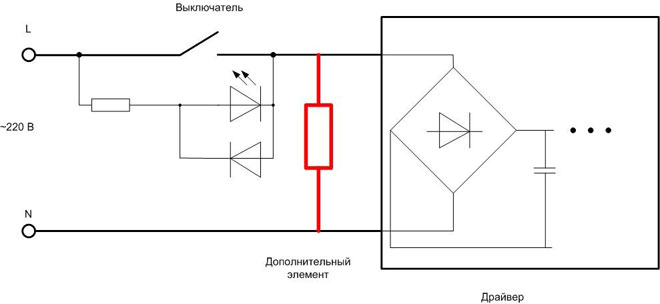
Better yet, connect a capacitor with a capacity of no more than 0.01 μF and a voltage of at least 400 V instead of a resistor. If the lamps form a parallel group, one additional element for all lamps is enough. You can connect it directly to the socket - it is more convenient. And you can also replace one LED light from the group with an incandescent bulb.
- To diagnose the wiring for leaks, you can use a megohmmeter. The test voltage should not exceed 500 V. When you take the measurements, you have to disconnect all consumers and also disconnect the main circuit breaker. The problem is that it is impossible to find the exact location of the fault. The entire section of wiring must be replaced, and if it is hidden, then a complete replacement is associated with a complete overhaul of the room.
- Capacitive connections can be "treated" in different ways. The connection between the phase wire and the neutral wire is drastically reduced by the use of a switch which breaks both conductors at the same time. The first problem is that such switches are not made in the domestic version, and those intended for industrial purposes have zero aesthetic component. A way around this is to use two-way switchby mechanically connecting the two keys inconspicuously for simultaneous switching. The second problem is in the wiring topology. The neutral wire to the switch is often not brought to the switch, it will have to be rewired. And breaking the neutral wire is undesirable for safety reasons. But this method can work in many cases.
It should be understood that often the problem of capacitive coupling cannot be solved even by replacing the wiring. Improved insulation of the new wire will only increase the capacitance of the parasitic capacitor. Therefore, you will have to radically change the topology of the wiring. This is expensive in terms of finances, labor and time. It might be cheaper to refuse LED lighting in favor of incandescent bulbs until the next major renovation of the room.
- The issue with poor quality LED light bulbs is solved in the easiest way. It is necessary to try to replace the lighting element with a device from another manufacturer. It is recommended to pay attention to the products of the world's leading manufacturers: Philips, Osram, Gauss, Feron and other well-known brands. If the problem is not with the lamp, but with the chandelier, you can try to replace the terminals and internal wiring. In some cases, this can help eliminate leaks due to poor insulation.
- Incorrect phasing can be corrected by reconnecting the phase and neutral wires. This should be done at any convenient location. For example, on the terminal block or in the junction box. But be sure to do it before the light switch.
The problem of LED lights glow does not belong to the unsolvable. The question is in the correct diagnosis - here a mistake can lead to unjustified financial and time losses.
Related articles:


